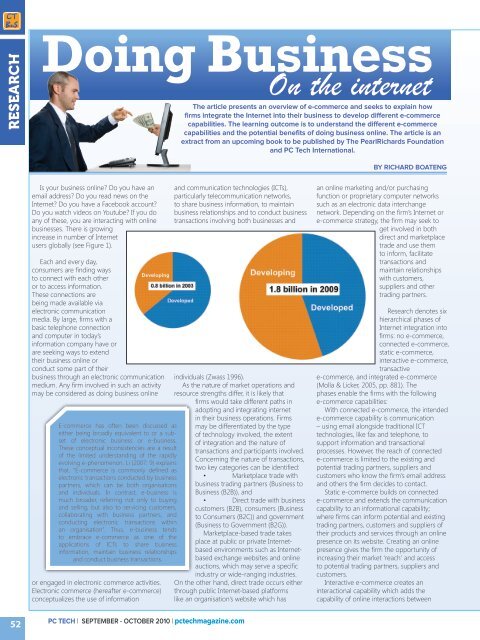Issue Seven - Conversations on Technology, Business and Society
Issue Seven - Conversations on Technology, Business and Society
Issue Seven - Conversations on Technology, Business and Society
Create successful ePaper yourself
Turn your PDF publications into a flip-book with our unique Google optimized e-Paper software.
RESEARCH<br />
52<br />
Doing <strong>Business</strong><br />
On the internet<br />
The article presents an overview of e-commerce <strong>and</strong> seeks to explain how<br />
firms integrate the Internet into their business to develop different e-commerce<br />
capabilities. The learning outcome is to underst<strong>and</strong> the different e-commerce<br />
capabilities <strong>and</strong> the potential benefits of doing business <strong>on</strong>line. The article is an<br />
extract from an upcoming book to be published by The PearlRichards Foundati<strong>on</strong><br />
<strong>and</strong> PC Tech Internati<strong>on</strong>al.<br />
Is your business <strong>on</strong>line? Do you have an<br />
email address? Do you read news <strong>on</strong> the<br />
Internet? Do you have a Facebook account?<br />
Do you watch videos <strong>on</strong> Youtube? If you do<br />
any of these, you are interacting with <strong>on</strong>line<br />
businesses. There is growing<br />
increase in number of Internet<br />
users globally (see Figure 1).<br />
Each <strong>and</strong> every day,<br />
c<strong>on</strong>sumers are finding ways<br />
to c<strong>on</strong>nect with each other<br />
or to access informati<strong>on</strong>.<br />
These c<strong>on</strong>necti<strong>on</strong>s are<br />
being made available via<br />
electr<strong>on</strong>ic communicati<strong>on</strong><br />
media. By large, firms with a<br />
basic teleph<strong>on</strong>e c<strong>on</strong>necti<strong>on</strong><br />
<strong>and</strong> computer in today’s<br />
informati<strong>on</strong> company have or<br />
are seeking ways to extend<br />
their business <strong>on</strong>line or<br />
c<strong>on</strong>duct some part of their<br />
business through an electr<strong>on</strong>ic communicati<strong>on</strong><br />
medium. Any firm involved in such an activity<br />
may be c<strong>on</strong>sidered as doing business <strong>on</strong>line<br />
E-commerce has often been discussed as<br />
either being broadly equivalent to or a subset<br />
of electr<strong>on</strong>ic business or e-business.<br />
These c<strong>on</strong>ceptual inc<strong>on</strong>sistencies are a result<br />
of the limited underst<strong>and</strong>ing of the rapidly<br />
evolving e-phenomen<strong>on</strong>. Li (2007: 9) explains<br />
that, “E-commerce is comm<strong>on</strong>ly defined as<br />
electr<strong>on</strong>ic transacti<strong>on</strong>s c<strong>on</strong>ducted by business<br />
partners, which can be both organisati<strong>on</strong>s<br />
<strong>and</strong> individuals. In c<strong>on</strong>trast, e-business is<br />
much broader, referring not <strong>on</strong>ly to buying<br />
<strong>and</strong> selling, but also to servicing customers,<br />
collaborating with business partners, <strong>and</strong><br />
c<strong>on</strong>ducting electr<strong>on</strong>ic transacti<strong>on</strong>s within<br />
an organisati<strong>on</strong>”. Thus, e-business tends<br />
to embrace e-commerce as <strong>on</strong>e of the<br />
applicati<strong>on</strong>s of ICTs to share business<br />
informati<strong>on</strong>, maintain business relati<strong>on</strong>ships<br />
<strong>and</strong> c<strong>on</strong>duct business transacti<strong>on</strong>s.<br />
or engaged in electr<strong>on</strong>ic commerce activities.<br />
Electr<strong>on</strong>ic commerce (hereafter e-commerce)<br />
c<strong>on</strong>ceptualizes the use of informati<strong>on</strong><br />
<strong>and</strong> communicati<strong>on</strong> technologies (ICTs),<br />
particularly telecommunicati<strong>on</strong> networks,<br />
to share business informati<strong>on</strong>, to maintain<br />
business relati<strong>on</strong>ships <strong>and</strong> to c<strong>on</strong>duct business<br />
transacti<strong>on</strong>s involving both businesses <strong>and</strong><br />
individuals (Zwass 1996).<br />
As the nature of market operati<strong>on</strong>s <strong>and</strong><br />
resource strengths differ, it is likely that<br />
firms would take different paths in<br />
adopting <strong>and</strong> integrating internet<br />
in their business operati<strong>on</strong>s. Firms<br />
may be differentiated by the type<br />
of technology involved, the extent<br />
of integrati<strong>on</strong> <strong>and</strong> the nature of<br />
transacti<strong>on</strong>s <strong>and</strong> participants involved.<br />
C<strong>on</strong>cerning the nature of transacti<strong>on</strong>s,<br />
two key categories can be identified:<br />
• Marketplace trade with<br />
business trading partners (<strong>Business</strong> to<br />
<strong>Business</strong> (B2B)), <strong>and</strong><br />
• Direct trade with business<br />
customers (B2B), c<strong>on</strong>sumers (<strong>Business</strong><br />
to C<strong>on</strong>sumers (B2C)) <strong>and</strong> government<br />
(<strong>Business</strong> to Government (B2G)).<br />
Marketplace-based trade takes<br />
place at public or private Internetbased<br />
envir<strong>on</strong>ments such as Internetbased<br />
exchange websites <strong>and</strong> <strong>on</strong>line<br />
aucti<strong>on</strong>s, which may serve a specific<br />
industry or wide-ranging industries.<br />
On the other h<strong>and</strong>, direct trade occurs either<br />
through public Internet-based platforms<br />
like an organisati<strong>on</strong>’s website which has<br />
PC TECH | SEPTEMBER - OCTOBER 2010 | pctechmagazine.com<br />
BY RICHARD BOATENG<br />
an <strong>on</strong>line marketing <strong>and</strong>/or purchasing<br />
functi<strong>on</strong> or proprietary computer networks<br />
such as an electr<strong>on</strong>ic data interchange<br />
network. Depending <strong>on</strong> the firm’s Internet or<br />
e-commerce strategy, the firm may seek to<br />
get involved in both<br />
direct <strong>and</strong> marketplace<br />
trade <strong>and</strong> use them<br />
to inform, facilitate<br />
transacti<strong>on</strong>s <strong>and</strong><br />
maintain relati<strong>on</strong>ships<br />
with customers,<br />
suppliers <strong>and</strong> other<br />
trading partners.<br />
Research denotes six<br />
hierarchical phases of<br />
Internet integrati<strong>on</strong> into<br />
firms: no e-commerce,<br />
c<strong>on</strong>nected e-commerce,<br />
static e-commerce,<br />
interactive e-commerce,<br />
transactive<br />
e-commerce, <strong>and</strong> integrated e-commerce<br />
(Molla & Licker, 2005, pp. 881). The<br />
phases enable the firms with the following<br />
e-commerce capabilities:<br />
With c<strong>on</strong>nected e-commerce, the intended<br />
e-commerce capability is communicati<strong>on</strong><br />
– using email al<strong>on</strong>gside traditi<strong>on</strong>al ICT<br />
technologies, like fax <strong>and</strong> teleph<strong>on</strong>e, to<br />
support informati<strong>on</strong> <strong>and</strong> transacti<strong>on</strong>al<br />
processes. However, the reach of c<strong>on</strong>nected<br />
e-commerce is limited to the existing <strong>and</strong><br />
potential trading partners, suppliers <strong>and</strong><br />
customers who know the firm’s email address<br />
<strong>and</strong> others the firm decides to c<strong>on</strong>tact.<br />
Static e-commerce builds <strong>on</strong> c<strong>on</strong>nected<br />
e-commerce <strong>and</strong> extends the communicati<strong>on</strong><br />
capability to an informati<strong>on</strong>al capability;<br />
where firms can inform potential <strong>and</strong> existing<br />
trading partners, customers <strong>and</strong> suppliers of<br />
their products <strong>and</strong> services through an <strong>on</strong>line<br />
presence <strong>on</strong> its website. Creating an <strong>on</strong>line<br />
presence gives the firm the opportunity of<br />
increasing their market ‘reach’ <strong>and</strong> access<br />
to potential trading partners, suppliers <strong>and</strong><br />
customers.<br />
Interactive e-commerce creates an<br />
interacti<strong>on</strong>al capability which adds the<br />
capability of <strong>on</strong>line interacti<strong>on</strong>s between


